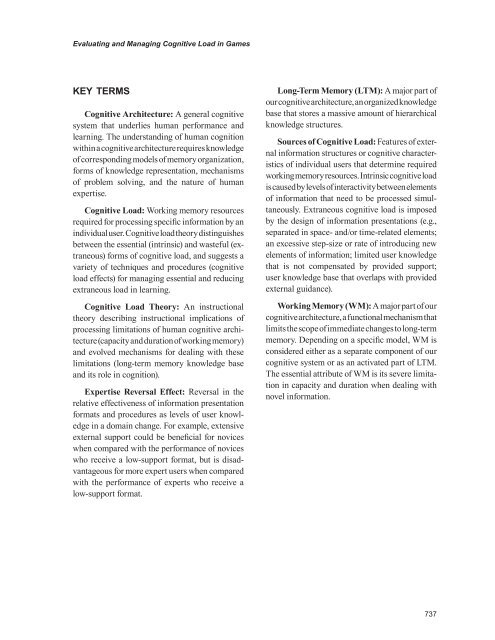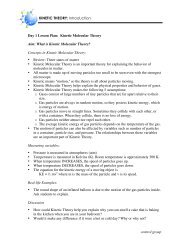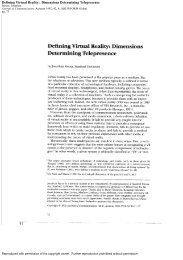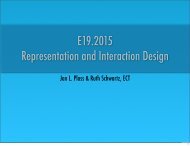Evaluating and managing cognitive load in educational games
Evaluating and managing cognitive load in educational games
Evaluating and managing cognitive load in educational games
Create successful ePaper yourself
Turn your PDF publications into a flip-book with our unique Google optimized e-Paper software.
<strong>Evaluat<strong>in</strong>g</strong> <strong>and</strong> Manag<strong>in</strong>g Cognitive Load <strong>in</strong> Games<br />
KEY TERMS<br />
Cognitive Architecture: A general <strong>cognitive</strong><br />
system that underlies human performance <strong>and</strong><br />
learn<strong>in</strong>g. The underst<strong>and</strong><strong>in</strong>g of human cognition<br />
with<strong>in</strong> a <strong>cognitive</strong> architecture requires knowledge<br />
of correspond<strong>in</strong>g models of memory organization,<br />
forms of knowledge representation, mechanisms<br />
of problem solv<strong>in</strong>g, <strong>and</strong> the nature of human<br />
expertise.<br />
Cognitive Load: Work<strong>in</strong>g memory resources<br />
required for process<strong>in</strong>g specific <strong>in</strong>formation by an<br />
<strong>in</strong>dividual user. Cognitive <strong>load</strong> theory dist<strong>in</strong>guishes<br />
between the essential (<strong>in</strong>tr<strong>in</strong>sic) <strong>and</strong> wasteful (extraneous)<br />
forms of <strong>cognitive</strong> <strong>load</strong>, <strong>and</strong> suggests a<br />
variety of techniques <strong>and</strong> procedures (<strong>cognitive</strong><br />
<strong>load</strong> effects) for <strong>manag<strong>in</strong>g</strong> essential <strong>and</strong> reduc<strong>in</strong>g<br />
extraneous <strong>load</strong> <strong>in</strong> learn<strong>in</strong>g.<br />
Cognitive Load Theory: An <strong>in</strong>structional<br />
theory describ<strong>in</strong>g <strong>in</strong>structional implications of<br />
process<strong>in</strong>g limitations of human <strong>cognitive</strong> architecture<br />
(capacity <strong>and</strong> duration of work<strong>in</strong>g memory)<br />
<strong>and</strong> evolved mechanisms for deal<strong>in</strong>g with these<br />
limitations (long-term memory knowledge base<br />
<strong>and</strong> its role <strong>in</strong> cognition).<br />
Expertise Reversal Effect: Reversal <strong>in</strong> the<br />
relative effectiveness of <strong>in</strong>formation presentation<br />
formats <strong>and</strong> procedures as levels of user knowledge<br />
<strong>in</strong> a doma<strong>in</strong> change. For example, extensive<br />
external support could be beneficial for novices<br />
when compared with the performance of novices<br />
who receive a low-support format, but is disadvantageous<br />
for more expert users when compared<br />
with the performance of experts who receive a<br />
low-support format.<br />
Long-Term Memory (LTM): A major part of<br />
our <strong>cognitive</strong> architecture, an organized knowledge<br />
base that stores a massive amount of hierarchical<br />
knowledge structures.<br />
Sources of Cognitive Load: Features of external<br />
<strong>in</strong>formation structures or <strong>cognitive</strong> characteristics<br />
of <strong>in</strong>dividual users that determ<strong>in</strong>e required<br />
work<strong>in</strong>g memory resources. Intr<strong>in</strong>sic <strong>cognitive</strong> <strong>load</strong><br />
is caused by levels of <strong>in</strong>teractivity between elements<br />
of <strong>in</strong>formation that need to be processed simultaneously.<br />
Extraneous <strong>cognitive</strong> <strong>load</strong> is imposed<br />
by the design of <strong>in</strong>formation presentations (e.g.,<br />
separated <strong>in</strong> space- <strong>and</strong>/or time-related elements;<br />
an excessive step-size or rate of <strong>in</strong>troduc<strong>in</strong>g new<br />
elements of <strong>in</strong>formation; limited user knowledge<br />
that is not compensated by provided support;<br />
user knowledge base that overlaps with provided<br />
external guidance).<br />
Work<strong>in</strong>g Memory (WM): A major part of our<br />
<strong>cognitive</strong> architecture, a functional mechanism that<br />
limits the scope of immediate changes to long-term<br />
memory. Depend<strong>in</strong>g on a specific model, WM is<br />
considered either as a separate component of our<br />
<strong>cognitive</strong> system or as an activated part of LTM.<br />
The essential attribute of WM is its severe limitation<br />
<strong>in</strong> capacity <strong>and</strong> duration when deal<strong>in</strong>g with<br />
novel <strong>in</strong>formation.<br />
737








